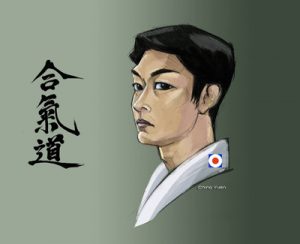 On Saturday 9th and Sunday 10th March 2019, Saito Morihiro Nidaime, Waka Sensei, son of the of Iwama Shin Shin Aiki Shurenkai head-of-school Saito Hitohira Juku-cho and officially appointed successor to lead the school, conducted an international koshukai (seminar) in Modena (Italy), at the versatile sports center “Alfeo Corassori”.
On Saturday 9th and Sunday 10th March 2019, Saito Morihiro Nidaime, Waka Sensei, son of the of Iwama Shin Shin Aiki Shurenkai head-of-school Saito Hitohira Juku-cho and officially appointed successor to lead the school, conducted an international koshukai (seminar) in Modena (Italy), at the versatile sports center “Alfeo Corassori”.
The second time ever he visited Italy, Waka Sensei had originally been invited by the late Alessandro Tittarelli Shihan (8th Dan ISSASK), former technical director of Iwama Shin Shin Aiki Shurenkai Italia. Following his untimely passing in September 2018, the Dento Iwama Ryu Italia group – now lead by Master Alberto Boglio Shihan (6th Dan ISSASK) – decided to take over the seminar organization, thus maintaining the invitation to Waka Sensei, also in an effort to honor M. Tittarelli’s memory. The exemplary logistics organization provided by Aikido no Musubi Modena of M. Roberto Santoro (4th Dan ISSASK) and the constant advice and support, as well as on-site presence in the last stages of the organization, of M. Stefano Di Carlo (5th Dan ISSASK) of Takemusu Aikido Torino, guaranteed a flawless progression of the seminar, a fact aided by the accommodating weather, usually more unstable at the beginning of March at such latitudes. Waka Sensei was able to display, as always, the highest level of his skills as practitioner and teacher, and the over one hundred participants could enjoy an honest, relaxed training, despite the high number of people.
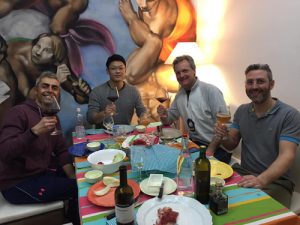
Many Italian and European Senpai of the school were present; beside the ones already cited above, a mention goes to Volker Hochwald from Takemusu Aikido Korntal (Stuttgard), Danilo Di Teodoro, Thomas Podzelny from Ki-Shin-Tai Dojo in Erlangen, Sergio Ravazzoni, Mirca Mazzavillani, Elmar Sterzl from Aikido Buchloe (Munich), Miki Nakajima from Kyoto (who was kind enough to translate from Japanese into English, while Stefano Di Carlo interpreted from Japanese or English into Italian) Victor Detrez from Tenchi Dojo Paris, who recently completed a one-year stay in Iwama as uchi-deshi.
The aikidoka who took part in the two-day-long training came from all over Italy, from Piemonte to Sicily, from Lombardia to Friuli Venezia Giulia, from Emilia Romagna to Marche and Lazio; although the majority was Italian, many budoka came also from France and Germany.

On Saturday and Sunday morning, training sessions were held outdoors as far as bukiwaza (practice with weapons) was concerned. The wide, grassy field near the main building of the sports center allowed for enough space for over fifty pairs of practitioners to train at a suitable distance and move freely, performing broad movements. Conversely, the Saturday afternoon keiko, which focused on taijutsu (bare hand techniques) took place in the main dojo, but required for people to form groups of three in order to perform the techniques safely and with ease.
At the beginning of each keiko, following the traditional etiquette typical of the Dento Iwama Ryu school, while paying homage to the kamiza that had been especially set up for the event, Morihiro Nidaime chanted a Norito (a Shintoist prayer, an invocation to the kami and the ancestors vocalized in a manner akin to Western Lamentations or Psalmodies). The intent was probably also to stress the inescapable relationship between one’s technical and motor development and their personal inner progress of enlightenment and in-depth spiritual research typical of O Sensei’s Traditional Aikido. This deep connection between Shintoist spirituality and O Sensei’s Aikido had already been highlighted by Saito Hitohira Kai-cho in the interview he took in Chartres in November 2012 (https://youtu.be/O-WKYaTCum4).
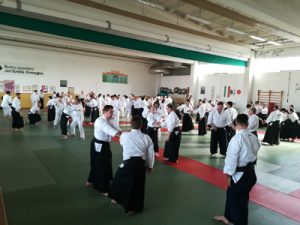
With regard to Aikiken (Aikido sword techniques), the program involved the fundamental practice of ken suburi (basic movements performed alone) and shiho-giri (cut in four directions) in the form of the first suburi. It then focused on the equally fundamentalgo no awase (harmonization of the fifth suburi) – go no awase is one of the pillars of ken (sword) practice in Aikido and of the whole corpus of techniques of O Sensei, due to the Riai concept– and moved on to the study of kumitachi (codified sparring exercise with a partner), the first (ichi no tachi) and second (ni no tachi).
Aikijo (Aikido techniques with the short staff) training began with the study of the twenty suburi forms and the harmonization of the kata of the 13 movements. It then analyzed kumijo (codified sparring exercise with a partner) from the first (ichi no kumijo) to the second version of the fourth (yon no ni).
In taijustu (bare hand techniques), the practice focused on katatedori tai no henko both kihon (basic form) and ki no nagare (flowing of ki), morotedori kokyu-ho and, finally, yokomenuchi ikkyo and nikyo (first and second principle) both omote and ura, yokomenuchi iriminage and kubinage (cut from the side, entering throwand neck throw) and its variations, ryotedori kokyunage (double hand grab breathing throw) in various forms, hanmihandachi waza (techniques in which the person attacked is kneeling while the attacker is standing) shihonage (throw in four directions) from many attacks and ushiro ryotedori kokyunage (breathing throw while both hands are being held from behind) in many variations, to finish off with suwariwaza ryotedori kokyu-ho (breathing exercise while kneeling and with both hands grabbed).
The recurring theme of Waka Sensei’s teaching was the constant reminder of how fundamentally important an extensive, honest study of each technique’s basics is; one cannot fathom to rise above them before purging them of any uncertainty and mistake, least of all resorting to haste and approximation. Sensei, while remarking on how each practitioner needs to be able to observe and duplicate what the teacher has shown in the short span of their explanation, took it upon himself to watch – and promptly correct – each pair or group of practitioners, before moving on to further clarifications or areas of study. Moreover, he repeated on several occasions how the concept of Kokoro (meant as sentiment or intention) is at the core of performing unyielding, confident techniques, characteristics which set Budo apart from combat sports.
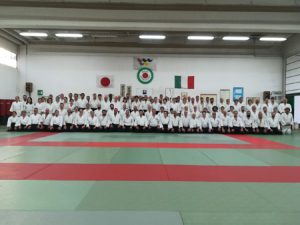 Many of the details underlined by Waka Sensei were precious learning material for those in attendance. For instance, the importance of fully raising one’s feet while practicing bukiwaza (paramount when training outdoors, not on the smooth surface of the tatami in a dojo) or of suitably balancing one’s weight. It is also imperative to perform techniques as they were presented by the Founder, and not their later, spurious variations, inefficient when confronted with intense, real attacks, which unfortunately characterize the training of many practitioners.
Many of the details underlined by Waka Sensei were precious learning material for those in attendance. For instance, the importance of fully raising one’s feet while practicing bukiwaza (paramount when training outdoors, not on the smooth surface of the tatami in a dojo) or of suitably balancing one’s weight. It is also imperative to perform techniques as they were presented by the Founder, and not their later, spurious variations, inefficient when confronted with intense, real attacks, which unfortunately characterize the training of many practitioners.
Waka Sensei also found the time to enrich his teaching with some anecdotes on Aikido and its origins – i.e. with Aikijo’s ushiro tsuki and how it originated from a technique Sokaku Takeda Sensei suggested to a blind life-convict from Hokkaido, so that he could defend himself from rear attacks – or on how the techniques from katatedori tai no henko, morotedori kokyuho and katame waza from ikkyo to rokyo are only preliminaries to the real practice, as explained also by Morihiro Saito Sensei in his books, not to forget how to perform harai on the third movement of the second kumijo in the learning forms presented by O Sensei and then by Morihiro Saito.
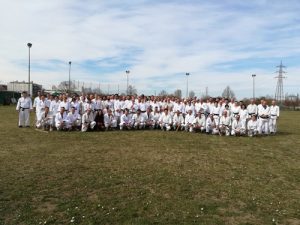
Waka Sensei was kind and patient enough to sit for a photo not only with the whole group of practitioners, but also with the participants divided by dojo and, at the end of the koshukai, even with some individuals. On Saturday evening, the group enjoyed themselves at the official party held at a renowned venue in Modena, which guaranteed a stylish, quality dinner during which people were able to mingle and celebrate the ongoing international event with jovial merriment.
At the end of the koshukai, Alberto Boglio Shihan, as technical director of the Dento Iwama Ryu Italia group, and Roberto Santoro, as organizer of the koshukai, thanked Waka Sensei and everybody who had worked in order to make the event possible. It was also the occasion to commemorate Alessandro Tittarelli Shihan, who was remembered with emotion in the presence, among others, of his daughter Francesca.
Morihiro Saito Nidaime, Waka Sensei, once again met and exceeded the expectations of all attendees, no matter their degree or level of experience. He also proved with no doubt that the Saito Family is the sole source to turn to in order to study with honest intent the Aikido of the Founder Ueshiba Morihei, O Sensei.
Text by: Enrico Neami
Photographs from: Aikido Dento Iwama Ryu Italia
Picture of Waka sensei by Chino Yuen
